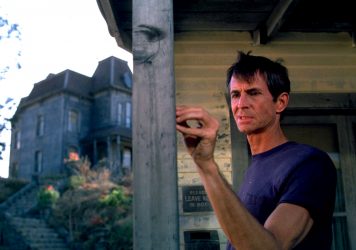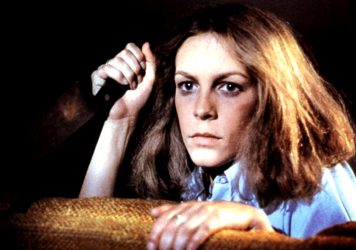
In horror, running up a staircase is a one-way ticket to near-certain doom. Putting the flight in flight-or-fight response, literally. In Wes Craven’s Scream, Sidney Prescott (Neve Campbell) dismisses horror movies because, “They’re all the same. Some stupid killer stalking some big-breasted girl who can’t act who is always running up the stairs when she should be running out the front door.” This critique quickly becomes Sidney’s reality when she has to take the stairs in order to escape the killer – not once, but twice – in the first instalment of the meta-horror franchise.
In new Netflix series The Haunting of Hill House, loosely based on the Shirley Jackson novel of the same name, creator Mike Flanagan utilises a number of horror conventions for maximum scare value. As with the characters in Scream, we know the techniques to look out for – something will appear in the negative space, timing is important when delivering a jump scare, and nothing good can come from a set of stairs.
Set over two timelines, the show follows the Crain family from the fateful summer they spent in Hill House through to the present day. The Haunting of Hill House delivers a number of creepy moments per episode, some as simple as a rattling doorknob or blink-and-you’ll-miss-it apparitions hiding in the shadows. Flanagan uses the sprawling Hill House location to highlight danger lurking in every as-yet undiscovered corner. A grand staircase the entranceway and a two-storey spiral staircase in the library are the connective tissue of this home.
“A house is like a person’s body. The walls are like bones, the pipes are the veins,” explains troubled matriarch Olivia (Carla Gugino) to daughter Shirley (Lulu Wilson). This metaphor is used throughout The Haunting of Hill House with the stairs acting as the throat – an entrance and an exit which threatens to swallow these characters whole or expel them.
Unsurprisingly for a horror, many of the scenes take place at night, yet the spiral staircase makes its first appearance during daytime hours in the first episode. It is backlit by stunning stained glass windows, but there is still a sense of foreboding as Shirley takes forever to ascend all the way to the top. Ropes hang off the side, seemingly part of the construction that is taking place within these walls. Adding to the sense of foreboding is its proximity to the mysterious Red Room, which cannot be unlocked.
A storm rages in episode six, with most of the action taking place at the foot of the grand staircase, mirroring the perilous weather conditions in the 1946 psychological horror The Spiral Staircase. Using the killer’s POV to heighten the audience’s sense of fear, the film bears the hallmarks of both the slasher sub-genre and the Final Girl trope, long before Jamie Lee Curtis wore that crown. Set in 1906, it sees a serial killer who is big into eugenics target disabled women in a small Vermont town. The spiral staircase is the centrepiece of the climactic scene as the killer chases his would-be victim up it.
Staircases are often used in horror to ramp up the tension, as well as to offer a semblance of hope, however misguided. Tripping up is, of course, a potential peril; falling down another. Something might even be unleashed, as in the case of 1982’s Poltergeist. And the scuttling ‘spider walk’ from 1973’s The Exorcist is among the film’s most enduring images, even though it didn’t make the original theatrical cut – performed by a contortionist, it is the only time Regan (Linda Blair) leaves the confines of her bedroom.
But stairs can also help to keep things out as much as they threaten to imprison. Toward the end of 1980’s The Shining as Jack (Jack Nicholson) loses control, his wife Wendy (Shelley Duvall) keeps him at bay with a baseball bat as she slowly backs up the Overlook’s grand staircase. Sometimes going up is better than going down.
Alfred Hitchcock utilised this everyday interior structure in a number of ways while experimenting with different camera movement. Scottie’s (James Stewart) bell tower ascent in 1958’s Vertigo uses an innovative and dizzying dolly zoom technique. Overhead shots have proven popular over the years, featuring memorably in Vertigo and Hitchcock’s 1960 Psycho and now in The Haunting of Hill House. The birds-eye perspective is particularly disorientating where a spiral staircase is concerned, as it becomes hard to distinguish between the top and bottom – an illusion with no beginning or end.
In Psycho, the camera stays with Milton Aborgast (Martin Balsam) as he slowly walks up the stairs; instead of running away from danger, he unknowingly walks toward it. Hitchcock switches to an overhead shot as Milton’s attacker stabs him, the camera staying on him as he tumbles backwards, capturing the horror that’s etched on his face in unnerving close-up.
Laurie Strode (Jamie Lee Curtis) is similarly attacked at the top of the stairs in John Carpenter’s original Halloween from 1978, though unlike Aborgast only her shirt is torn. Laurie is propelled over the bannister, which is both a blessing and a curse – it is a quick way to escape, but it does leave her injured. The use of a staircase in this scene is a direct nod to both Psycho and The Exorcist.
As executive producer Irwin Yablans explains in the second episode of The Ringer’s Halloween Unmasked podcast, one of his stipulations was for Carpenter to include a set of stairs because Psycho and The Exorcist, “both had important staircases. I said [to John], ‘Put a staircase in this movie. Staircases are scary because you don’t know what’s at the end of the staircase.’” (David Gordon Green’s recent Halloween sequel takes this production design cue a step further.) Forty years later, audiences knows exactly what is lies at the end of the staircase – and it is just as terrifying as ever.
Published 20 Oct 2018

By Adam White
Wes Craven’s seminal 1996 film occupies a uniquely female space.

By Anton Bitel
Richard Franklin’s follow-up to the Hitchcock classic is a chilling horror in its own right.

Fear and violence aren’t the only things that John Carpenter’s boogeyman brings to Haddonfield.